We are fitting collars to primates and to leopards in order to gain a better understanding of predator-prey interactions. In order to do this we must trap or dart the animals, which can be a challenging process for all involved, and here at the PPP we have had a busy few weeks of it! Caroline Howlett, the Primate Research Coordinator for the PPP has all the details:
To catch a vervet: Violet’s story
What you will need:
1. 2 x Tom and Jerry Cartoon style boxes held up with a stick.
2. Copious amounts of tasty fruits such as oranges, apples, bananas.
3. Patience and perseverance.
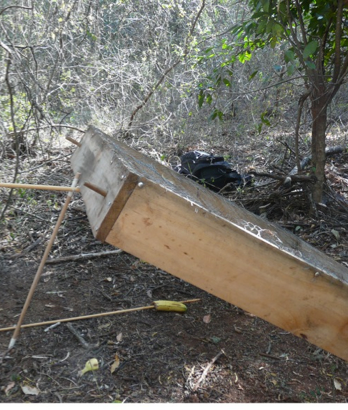
I’d been pre-baiting two un-set vervet traps with fruit everyday for several weeks to get the monkeys used to going in and out to take the treats. The monkeys were visiting the traps in the forest and taking the fruit on an almost daily basis. However, I discovered that bushbabies are thieves and will steal bait if the vervets don’t travel past the traps to claim it during the day. With some mini-experimentation it appears that the bushbabies at Lajuma love banana, apple and pear…but don’t like oranges!
Finally the day came when Adrian Tordiffe, an excellent wildlife vet that we work with, arrived at Lajuma to help us with the collaring work. On the very first morning I set the traps, as I was walking to check them, I heard a loud clang. As luck would have it, an adult female Vervet monkey had been caught in the trap. The rest of the troop scattered and watched from a distance in the trees. Despite the frightening situation of being in the trap she still had the good sense to calmly finish eating her oranges before Adrian arrived to sedate her. Once she was asleep, Adrian carefully placed her into a carry box which my cat Bandit very generously leant her for the occasion. Once the VHF collar had been fitted on her and she was awake, I named her Violet the Vervet, and we released her back out into the forest where she quickly rejoined her troop.
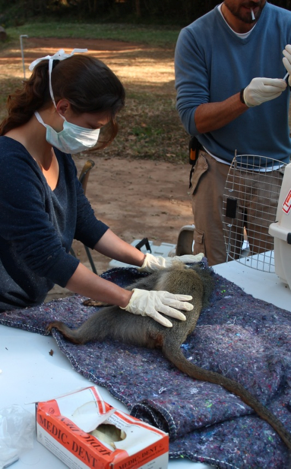
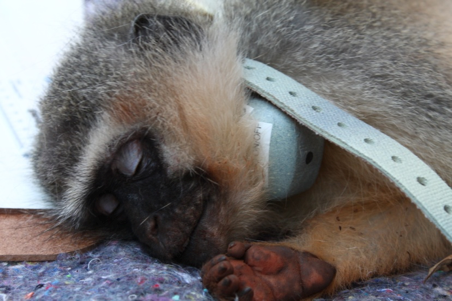
Violet is doing just fine and the collar is working well so far and is a huge help to the primate research assistants, who need to find the troop in order to habituate them to observer presence. After two weeks their response to us is already waning and we are able to spend a large part of the day following them receiving only a curious response where before they might have fled at the sight of a human. Being able to find the troop each day and locate them again after losing them using the VHF has a lot to do with the quick success we are having so far.
You can see violet being released with her new collar here:
To catch a samango: Geordie’s Story
What you will need:
1. 1 x vet with impressive darting skills.
2. 1 x large fig tree with lots of distracting fruit on it.
3. Patience and perseverance.
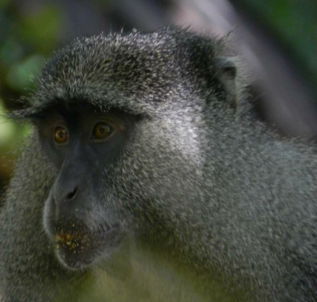
Last week one of our samango assistants Raphaella had seen a sub-adult male samango with a horrific wound on his arm. Ian, the owner of Lajuma, asked Adrian to see if he could do anything to help this injured monkey. Adrian managed to dart him and treat the wound which turned out to be a very nasty bite wound probably from fighting with another male samango. Adrian suggested we tag his ear so that he could be identified again in order to see how far the lone males travel in search of new troops. He got black and white tags and the name Geordie (in honor of my home town Newcastle) and he was released back to the other bachelors shortly afterwards. His arm is healing nicely and he is still hanging around in the little bachelor troop causing trouble for Barn Troop’s new alpha male.
To catch a baboon: Melissa’s story
What you will need:
1. 1 x vet with impressive darting skills.
2. Tons of dried corn kernels.
3. Patience and perseverance.
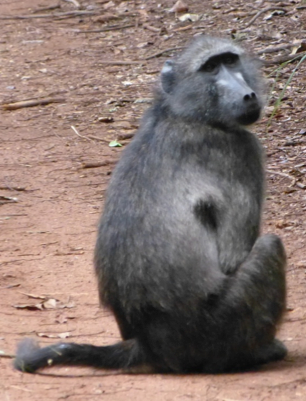
Since Lobelia’s collar fell off automatically when it’s battery ran out in March, the habituated baboon troop has been without a GPS collar. The baboon’s home range has extended massively in recent months and they are most frequently ranging in remote places where the bush is too thick and terrain too mountainous to attempt free-darting. For the past few months the baboon research assistants and I had been baiting an open grassland area which would be a better place for darting with corn kernels. It took the baboons a while to notice the corn but once they did they visited the site regularly usually spending an hour or so foraging after leaving their sleeping site in the morning and a few hours in the afternoon before heading back to bed.
For continuity we hoped to re-collar Lobelia but she has a dependent infant named Latch who still spends a lot of time riding jokey on his mother’s back. For the safety of little Latch, we decided to collar another female who wasn’t nursing and chose Melissa who is currently cycling, a close relative of Lobelia (probably a younger sister) and one place above her on the dominance hierarchy.
The baboons all came to visit the trap site in the afternoon of the 27th and I called Adrian, Sam and baboon research assistant Kasim on the radio as soon as they arrived. The baboons were very calm and absorbed in foraging in the long grass for the small kernels. I pointed Melissa out to Adrian and she was so busy threatening the other baboons close by to stay away from her patch of corn kernels that she didn’t notice him taking aim. He darted her successfully and she ran around 30 meters and after a few minutes of searching Kas and I found her asleep under a tree and carried her to where Adrian was waiting to fit the GPS collar.
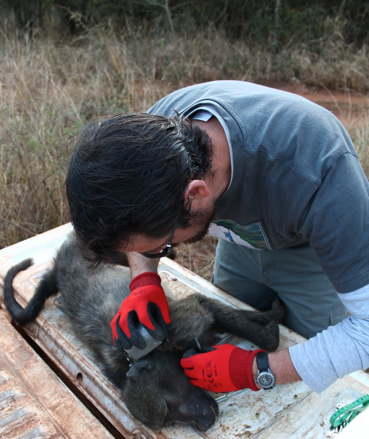
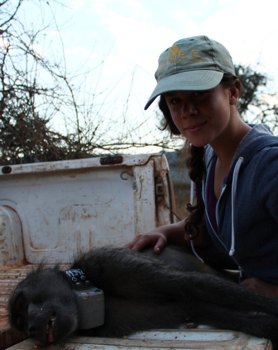
The troop began to move off a little while before she was awake enough to be released and so I followed them to see where they would sleep while Sam and Kas loaded her onto the car in her recovery crate to drive her to the sleeping site.
We released her an hour later at Wilderness Camp where the rest of the troop were relaxing before going down to sleep on the cliffs below. She was greeted by other members of the troop and went to bed with them on the cliffs. I checked on her the next morning she looked healthy and was behaving normally. I’m just hoping she won’t bear a grudge!
Hopefully things will go as smoothly as they did this time if we ever need to catch a monkey again!
A massive thank you to Adrian for all his help over the past two weeks!
